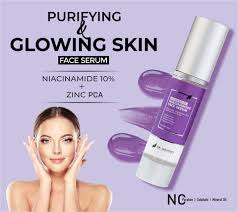
Can I use Salicylic Acid Cleanser and Niacinamide Together?
When it comes to layering skincare ingredients, the general idea is to keep in mind that the pH levels of the formulation and the blend of active ingredients as an imbalance can cause a lot of damage then you’d imagine.
Luckily for us, yes, niacinamide is perfectly safe to use with salicylic acid due to the fact it contains humectant properties. This allows the ingredient to absorb moisture from the surrounding atmosphere and other product formulas and locking them into the different layers of the skin. Another unique benefit of niacinamide is the fact it can regulate sebum production of the skin making it a highly effective ingredient for those prone to acne. With salicylic acid being one of the most used BHA in blemish fighting products it makes perfect sense to team both powerhouse ingredients together.
As for the focus of today’s blog post, we will be looking into specific products formulations and how this can determine how your skin reaps the rewards. So, with that in mind, let’s investigate whether you can use salicylic acid cleanser and niacinamide together.
Can I use niacinamide with salicylic acid cleanser?
Absolutely, salicylic acid is one of the most potent skincare ingredients, it does come with some side effects of dryness and irritation. This is often a result of when you first introduce active levels of the BHA into your daily routine. If salicylic acid is a completely new ingredient for you then using a cleanser is the best start.
One of the major benefits of opting for a cleanser to introduce such a potent ingredient as salicylic acid. This is because the percentage of the ingredient is usually lower in products that don’t tend to not remain on the skin for extended amounts of time, such as face cleansers and face washes. With cleanser formulas enriched in salicylic acid you’ll slough away the build-up of layer of dead skin cells, bacteria, and impurities. This will not only keep the skin fully cleansed, but you will ensure any other products, including those packed with niacinamide applied to the skin will absorb quickly and effectively.
Can I use salicylic acid cleanser and serum together?
Yes, you can, but this is very dependent on the formula of the serum. As I have already said, salicylic acid is a highly potent skincare ingredient which is why it’s best to avoid using it with other acids, such as the popular AHA glycolic acid and lactic acid. Combining salicylic acid cleanser with a serum that is packed with hyaluronic acid will provide hydration for the skin and counteract any signs of dryness caused by the BHA. Using this duo of products will be beneficial for those prone to oily, acne-prone skin, for those who tend to be drier will find this is the best way of reaping the rewards without the unwanted skin irritation.
What goes first salicylic acid or niacinamide?
When it comes to layering salicylic acid and niacinamide it is important to remember to give the skin enough time in between applications. The reason this is considered an important part of your skincare routine is due to keeping the pH levels on the skin as neutral as possible. With salicylic acid being, well, acidic I suggest applying it to the skin first and leave 10-15 minutes to follow this with niacinamide. Niacinamide works best in an environment that has a neutral pH so leaving enough time between salicylic acid application will ensure you gain the optimal results to the complexion. If you are wanting to know more about how to use niacinamide and salicylic acid together, check out our dedicated blog post.
Is niacinamide or salicylic acid better for acne?
Both are great and highly effective to use in an anti-blemish routine. Luckily for us niacinamide and salicylic acid can be used together if they are used correctly.
Salicylic acid is oil-soluble meaning it can penetrate deeply into the pores and lower layers of the skin. This results in any build-up of excess sebum, bacteria and other impurities that lead to blemishes, acne, and breakouts. It is also able to rid the skin of dead skin cells by chemically exfoliating the complexion leaving you with cleansed, healthy skin.
Niacinamide can give the skin a boost in hydration thanks to the humectant properties. This ensures the skin barrier is fully functioning and able to protect itself from daily aggressors which causes damage to the skin. This clever humectant can also work at regulating the balance of the skin surface by maintaining the production of sebum.
Can you use salicylic acid cleanser every day?
This very much depends on your skin type and how much you have built your skin’s tolerance. For those with an oily and blemish-prone skin type you may find that using salicylic acid cleanser twice a day will ensure you are fully cleansed and clear of any blemish causing impurities.
Much like all skincare products it is best to carry out a patch test for 24 hours before applying it all over the face, especially if it includes a new ingredient. If you still have some concerns or worries you can also consult with a doctor or dermatologist to make sure you and your skin will be happy with using salicylic acid every day.
Can I use moisturiser after salicylic acid?
Yes, you can indeed! In fact, by applying moisturiser to the skin after salicylic acid will restore the natural protective barrier, replenishing the water levels and balancing the oils. The beauty of moisturisers is the fact that they help hydrate the skin, as well as form a physical barrier on the outer surface keeping damaging particles off the skin whilst locking in any active ingredients underneath.
Should I use niacinamide in the morning or night?
You can use niacinamide in the morning and night. By applying it twice a day you are ensuring the skin has constant hydration enabling it to protect itself from exposure to free radicals, such as pollution, UV rays and other environmental aggressors. When your skin barrier is full of the correct water and oil levels you will also find that any other products applied to your face will penetrate quickly because the skin is acting like a wet sponge and is highly absorbent.
I hope that today I have cleared up some questions you have about using salicylic acid cleanser with niacinamide. Don’t forget you can come and find me on Instagram if you have any questions!


